TL;DR
- AI Overviews place Google’s AI-generated summaries at the top of search results, making them essential for visibility and authority.
- AI Overviews differ from traditional SEO by focusing on clarity, structured content, semantic optimisation, and authority signals.
- Key strategies include answering user questions, using schema markup, writing in simple language, fixing technical SEO, and updating content regularly.
- Top tools for success include SEMrush, ChatGPT, schema generators, and Google Search Console, while avoiding keyword stuffing and outdated info is crucial.
- Wild Creek Web Studio helps businesses optimise for AI Overviews and achieve top positions in search results.
If you have searched on Google lately, you have probably noticed those AI-generated summaries at the very top of the search engine results. That is AI Overview, Google’s way of giving quick, direct answers by pulling the best bits from multiple trusted sources.
Infact, AI Overviews now appear in almost 55% of Google search results. So, if you are not thinking about how to rank in AI Overview, you are missing out on a big slice of search visibility in the age of AI.
In this guide, we will cover what AI Overview is, how it works, and the exact strategies which is a perfect AI SEO guide to optimise your content for AI search so you can claim that prime top-of-page spot.
What Is AI Overview?
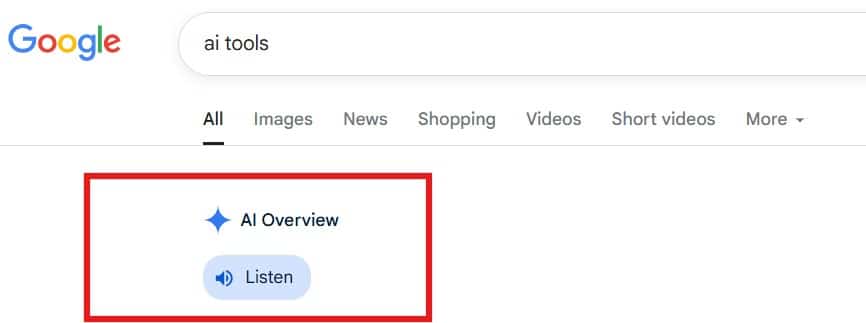
AI overview in Google page
An AI Overview is Google’s latest artificial intelligence feature designed to give users instant, comprehensive answers directly on the search engine results page. Instead of only listing links, Google’s generative AI overviews scans multiple high-quality content sources, extracts the most relevant information, and combines it into a single, easy-to-read summary.
This summary appears above traditional organic search results, making it one of the most valuable spots in the SERP for visibility. It is essentially Google’s way of saying, “Here is the answer you need, and here are the trusted sources we used to build it.”
AI Overviews can include:
- Short text summaries of a topic or question.
- Bullet points or numbered lists for steps and tips.
- Tables for comparisons or data-heavy queries.
- Links to the original sources for further reading.
Why AI Overviews Matter For Your SEO Strategy?
Why is it important to rank in Google’s AI Overviews? AI Overviews aren’t just a flashy new feature; they’re changing user behaviour. Google itself reports that AI overviews lead to higher search satisfaction, with users asking longer, more complex questions. They also drive better quality clicks, as visitors who arrive via an AI Overview are more likely to stay and engage because the content matches their intent.
If your content appears in an AI Overview, you gain:
- Prime placement at the very top of search results.
- Authority signals by being cited as a trusted source.
- Potential traffic boosts from users clicking the citation links.
With AI Overviews becoming a regular part of the search experience, content optimisation for AI search is now essential. Learning these strategies early will help secure a top spot and keep it.
What Are The Differences Between AI Overviews And Traditional SERPs?
| Feature | Traditional Search Engines | AI Search Engines (AI Overviews) |
| Ranking Focus | Backlinks, keywords, page authority | Topic authority, direct answers, structured data |
| Content creation Format | Long-form, keyword-dense, general | Concise, context-aware, user query driven |
| SERP Features | Organic results, featured snippets | AI summaries, interactive panels, tables, lists |
| Optimisation Tactics | On-page SEO, link-building | Clarity, schema markup, comprehensive coverage |
So, what are the key differences between optimizing for traditional Google search results and optimizing for AI Overviews?
The main difference lies in how content is selected and presented. Traditional SEO rewards pages that rank highest based on backlinks, keywords, and relevance. But SEO in AI world rewards clarity, topical authority, and structured content that AI can interpret.
In other words, ranking first in organic results does not automatically get you into AI Overviews. Your content must be structured so the AI can quickly understand, summarise, and cite it as a credible source.
How Do You Secure A Spot In Google’s AI Overviews? (8 Proven Strategies)
If you want to know how to rank in AI Overview results, you need to understand what Google’s generative AI is looking for. When applying optimization techniques in AI, the goal is to make your content not only searchable but also easily digestible for Google’s generative models.
These methods align perfectly with AI for content creation and optimization, ensuring both human readers and AI engines find value.
Below are the most effective AI Overview SEO strategies to help you get featured.
1. Pinpoint The Questions People Are Actually Asking

People also ask section
AI Overviews are triggered most often by informational queries that start with “how to”, “what is”, “why”, or “best ways to”. These signals tell Google’s AI that the user is looking for a direct answer, making your content a prime candidate for inclusion.
How to optimize content for generative ai:
- Use tools like Google’s People Also Ask section, AnswerThePublic, and SEMrush to find common question-based searches in your niche.
- Include those questions as H2s or H3s in your content and answer them clearly. This is an important strategy of AI for content optimization
- Keep your answers clear and factual so AI can easily extract and summarise them.
Example: When you’re writing a blog on AI Overview optimization, these are some of the keywords you can naturally target:
- What is AI Overview? – Explaining the feature and its role in Google search results.
- How to rank on AI Overview – Step-by-step tips for content creators to optimise for AI-triggering search queries.
- Benefits of AI generative overviews SEO – Highlighting how it boosts search engine visibility, improves user experience, and drives more engaged clicks.
2. Write Like You’re Explaining It To A Friend
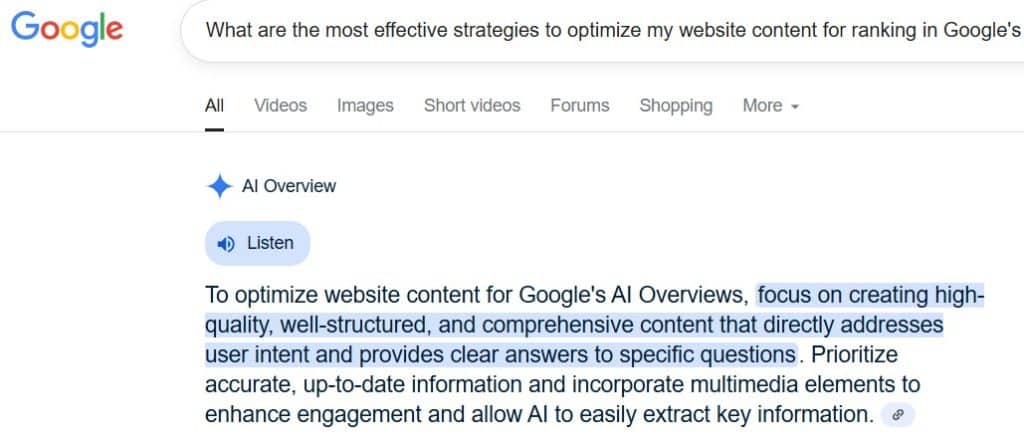
AI overview
If you’re asking What are the most effective strategies to optimize my website content for ranking in Google’s AI Overviews? This is one of the best known strategies.
AI Overviews are powered by generative AI that is designed to simplify complex topics for users. If your content is too technical or cluttered, the AI might skip it in favour of clearer, more accessible sources.
How to optimise for this:
- Use short sentences and plain natural language, avoiding jargon unless you explain it.
- Break down complex ideas into bite-sized points.
- Match your tone to natural search patterns, similar to the way someone might type a query into Google.
Pro Tip: When you review your draft, ask yourself: If I read this aloud, would it sound natural and easy to understand?
3. Make Your Content Easy For AI And Humans To Scan

Headings and Bullet points in AI Overview
One of the biggest factors in AI Overview optimisation is structure. The easier it is for AI to parse your content, the more likely it is to feature your site.
How to optimise for this:
- Use H2 and H3 subheadings to organise content logically.
- Use bullet points, numbered steps, and short paragraphs. This SEO optimization AI tactic helps both humans and AI summarise quickly.
- Include a TL;DR or key takeaways section to summarise the main points.
Example:
If you are writing about how to optimise content for AI search, list each step clearly in order rather than burying them in long paragraphs.
4. Show Google You’re A Trusted Expert
For people still wondering, how does ai overview work. Yo should understand that Google’s AI does not just want content; it wants credible content. Trust signals and authority-building measures can set you apart from competitors.
How to optimise for this:
- Provide accurate, well-researched valuable insights with references to reputable sources.
- Add author bios that highlight expertise in the topic area.
- Link to professional profiles like LinkedIn or industry publications.
- Use structured data (schema markup) to clearly define your author, content type, and topic.
- Build topical authority with content clusters around major themes in your niche.
5. Optimise For The Way People Really Search
Generative AI works differently from traditional keyword-matching algorithms. It understands context, which means your AI SEO strategy should prioritise semantic search and conversational language.
How to optimise for this:
- Use related terms, synonyms, and contextually relevant phrases in your content.
- Optimise for voice search by writing in a conversational tone and answering questions directly.
- Include examples, comparisons, and scenarios that match how people phrase real search queries.
Example:
Instead of just targeting “AI overview optimisation”, also use variations like how to optimize for AI overviews, AI optimization techniques, and SEO in the AI world.
6. Get Your Technical SEO In Top Shape
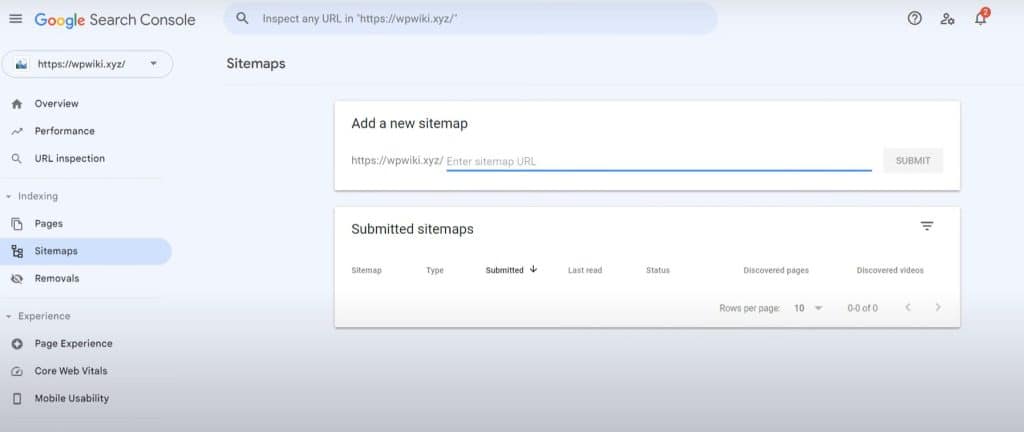
XML sitemap
Even the best content will not get featured if your site is slow, hard to crawl, or not mobile-friendly. Technical optimisation is most effective AI optimization for visibility improvements.
How to optimise for this:
- Ensure your site loads in under 2 seconds on both desktop and mobile.
- Use responsive design for a seamless mobile experience.
- Submit an XML sitemap and fix crawl errors in Google Search Console.
- Apply structured data to clarify your content for AI processing.
Pro Tip: Check your Core Web Vitals regularly. Slow load times and poor mobile usability can hurt your AI Overview chances.
7. Keep Improving Based On Real Performance Data
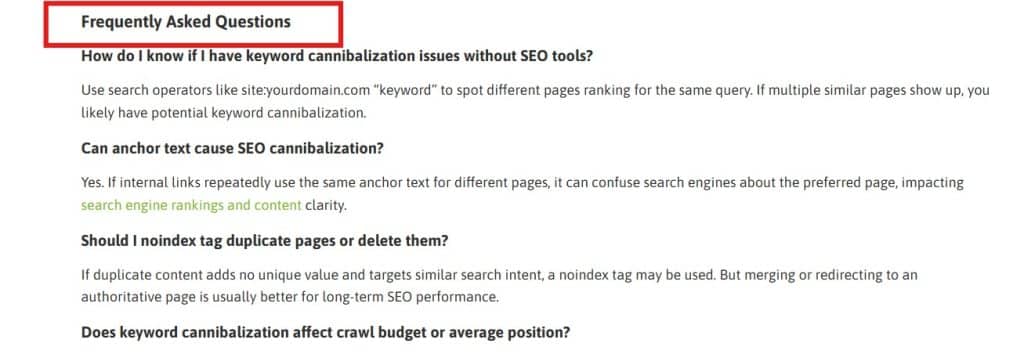
FAQ section on Wild Creek blog
AI Overview rankings are dynamic. What works today might need updating in a few months. Tracking performance lets you adapt before your competitors do. And, this content optimization AI loop keeps you relevant as well.
How to optimise for this:
- Use Google Search Console to see if your content is appearing in AI Overviews.
- Monitor competitors who get featured and analyse their content format.
- Refresh your content regularly to keep it accurate and up to date.
- Test different formats like FAQs, comparison tables, and step-by-step guides (like the FAQ format shown above).
Remember: Consistency is key. AI rewards content that remains relevant, well-maintained, and trustworthy over time.
8. Measure And Optimise For AI Overview Performance
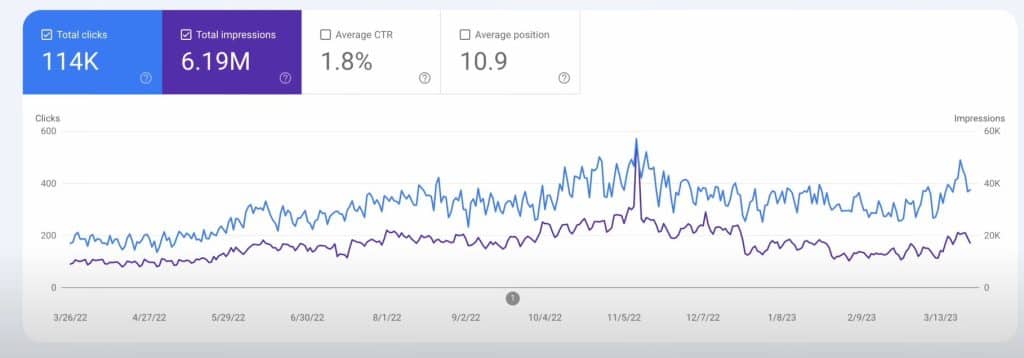
Google search console
You cannot improve what you do not measure. To know whether your AI Overview strategy is delivering results, you need to observe AI overview by tracking metrics that directly connect to this search feature.
To do this you can focus on:
- Impressions and clicks from queries that trigger AI Overviews
- Click-through rates for those appearances, showing how enticing your snippet is
- Average position changes for your targeted keywords
- Conversions from visitors who arrive via AI Overviews
These insights reveal not just whether you are getting the search engine visibility, but whether that visibility is driving real business results.
What Are the Best Tools To Boost Your AI Overview Rankings?
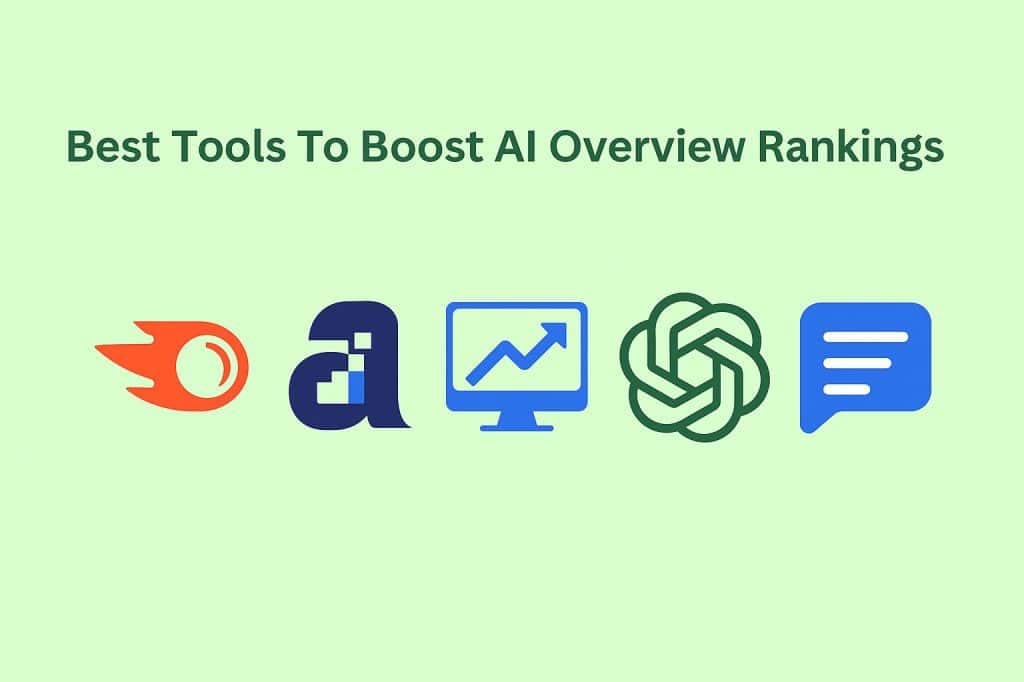
Image showing some of the best tools to boost AI overview rankings
If you want to rank in AI Overview results, you need more than great content. You need the right toolkit! So, let’s look at the tools that can help you identify opportunities, optimise effectively, and get your valuable content chosen by Google’s AI.
1. Keyword Research Tools For AI Overview Wins
Tools such as Semrush, Ahrefs, and SE Ranking help you discover the exact keywords that trigger AI Overviews. You can filter for question-based queries, “how-to” searches, and long-tail conversational phrases, which are more likely to generate AI Overview results.
Pro Tip: Look for keywords where AI Overviews appear but the competition is still low. This gives you a better chance of claiming visibility before the space becomes saturated.
Why it matters: If you do not know which queries trigger AI Overviews, you risk optimising SEO content that will never appear there. Targeting the right keywords puts you in contention from the start.
2. AI Structuring Tools for Readability
Google’s generative AI prefers content that is well-structured and easy to summarise. This helps in content optimization for AI search. Tools like ChatGPT, SurferSEO, and Frase can help you organise your web pages so they are AI-friendly. This includes:
- Clear H2 and H3 headings
- Concise paragraphs
- Bullet points and numbered steps
- Direct answers near the top of the page
Why it matters: Even strong content will be overlooked if it is hidden inside long, unstructured paragraphs. A clear structure makes it easy for AI to extract and display your information.
3. Schema Markup Tools For Better Signals
Google’s AI relies heavily on structured cues to interpret content. Using Google’s Rich Results Test, Schema.org Validator, or Merkle’s Schema Generator, you can add and test schema markup that labels your content type, authorship, and relevance.
Why it matters: Schema provides explicit signals that help AI identify the nature of your content. For example, marking up a guide as “HowTo” tells AI exactly what it is and increases the likelihood of being featured.
4. SERP & Competitor Tracking Tools To Learn From Those Already Ranking
Tools such as Advanced Web Ranking and Similarweb, along with manual incognito searches, allow you to see which competitors are winning AI Overview spots. Look at how they format their answers, the question types they target, and whether they use lists or tables.
Why it matters: AI Overview rankings are dynamic. By monitoring competitors, you can adapt your content quickly and identify openings before they are taken.
5. Performance Monitoring Tools To Track Results and Refine
Google Search Console is an essential tool for tracking impressions, clicks, and rankings for AI optimisation queries that could trigger AI Overviews. Pair it with GA4 to measure whether these appearances are driving traffic and engagement.
Why it matters: Without performance tracking, you are guessing. Monitoring results helps you identify what is working and refine your strategy for better outcomes.
Why Your Content Isn’t Making It Into AI Overviews?
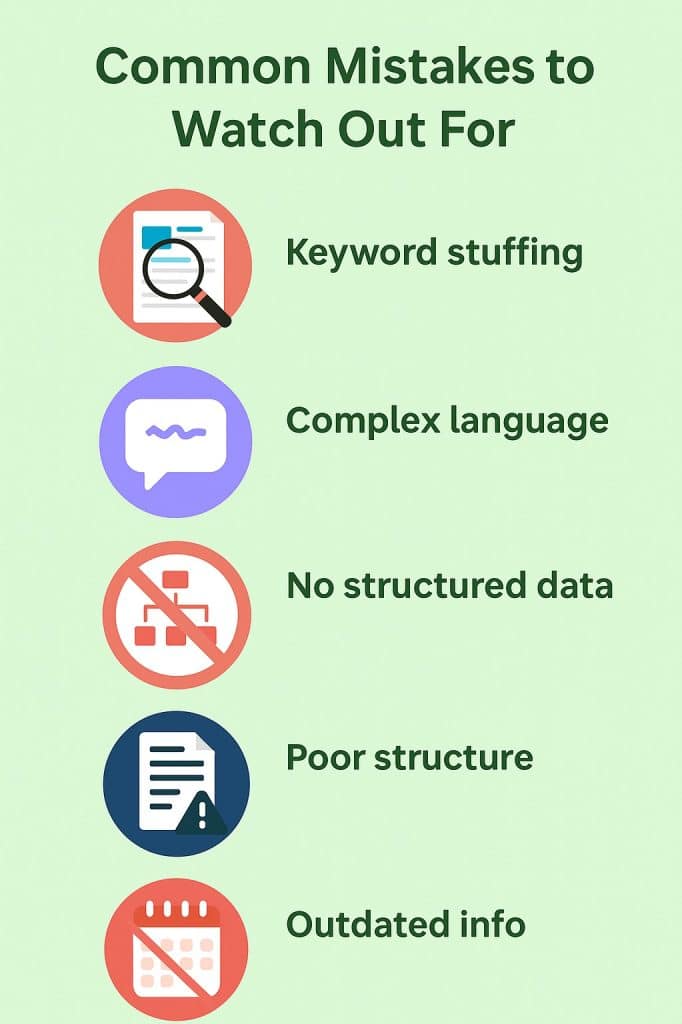
Common mistakes to watch out while creating content for AI overviews
If you’re asking What common mistakes should I avoid when trying to optimize for Google’s AI Overviews? Well, many sites miss AI Overview spots because they overlook how Google’s generative AI selects content. Here’s what to avoid:
- Keyword stuffing makes content look unnatural and reduces relevance. Instead, write with the search intent in mind and let the target keywords flow naturally.
- Overly complex language slows AI’s ability to summarise your content. Use clear, conversational language and keep sentences short.
- Ignoring structured data means AI may misinterpret your content which may in turn hinder AI optimisation. Adding the right schema helps it understand your page.
- Poor content structure hides important answers inside long text blocks. Use headings, bullet points, and concise sections.
- Outdated information hurts your credibility. Keep pages updated with accurate stats and current best practices.
Avoiding these pitfalls gives AI a clear, trustworthy, and easy-to-use source, increasing your chances of being featured.
How Can AI Insights Drive Real Business Growth Beyond Rankings?

Infographic showing how AI insights drive business growth
Ranking in AI Overview is great, but it is only the beginning. The real opportunity lies in using those AI-driven insights to transform how you attract, engage, and retain customers. Here is how successful brands are doing it:
1. Personalisation That Feels Human
The old version of personalisation was adding a first name to an email. Today, AI makes it possible to create experiences that feel truly individual.
It analyses browsing habits, purchase history, and real-time behavior to recommend products or content that customers genuinely care about.
Example:
You visit a fashion website and instead of random products, you see outfits that fit your size, match your style, and complement what is already in your cart. That is AI-powered personalisation in action, and customers respond to it.
2. Predicting What Customers Want Before They Do
Imagine knowing the next big trend before anyone else. AI makes that possible.
By studying search data, social media conversations, and purchase patterns, AI can forecast what your audience will want next. This gives businesses the chance to adjust inventory, launch campaigns, and position themselves ahead of competitors.
Example:
A food delivery app notices an upcoming demand for plant-based meals through AI trend analysis. They update their menu and promote vegan options early. By the time the trend peaks, they are already the preferred choice.
3. Customer Experiences That Matter
AI is not just about speed. It is about anticipation. It allows businesses to deliver the right content, at the right time, on the right platform.
From personalised landing pages to chatbots that solve problems instantly, AI creates a seamless user experience that keeps customers engaged and loyal. No more long wait times for responses. No irrelevant suggestions. Every interaction feels easy, relevant, and helpful.
What Could Go Wrong With AI?

Infographic showing What could go wrong with AI
While AI can transform digital strategies, businesses must approach it carefully. Here are challenges you need to keep in mind:
- Data privacy concerns: Customers expect transparency about how their information is collected, stored, and used. Clear privacy policies and strong security measures build trust and reduce legal risks.
- Bias in AI outputs : AI models can unintentionally reflect biases in the data they are trained on. Regular monitoring, fact-checking, and adjusting content are key to ensuring accuracy, fairness, and credibility.
- Technical issues or limitations: Implementing AI effectively requires the right infrastructure, tools, and skills. Investing in training or partnering with experts can help teams overcome these barriers and make the most of AI’s potential.
By recognising these challenges early, businesses can put safeguards in place and adopt AI in a way that delivers results without compromising trust or quality.
How Wild Creek Web Studio Puts You In Google’s AI Overviews?
Landing in Google’s AI Overviews isn’t about luck. It’s about showing up as the exact answer users and Google’s AI are looking for. And, if you’re worried on and align with how to use AI features in conversational search queries, that’s where Wild Creek Web Studio comes in.
We don’t just tick SEO checkboxes. We:
- Spot the right opportunities by identifying AI overviews SEO strategies before your competitors.
- Shape content AI loves with clear, structured, and user intent-driven copy
- Send the right signals with schema markup, technical SEO, and trust-building strategies
- Adapt fast as Google’s AI keeps evolving
The result is more visibility, better clicks, and a stronger position in the search results of tomorrow.
Contact us today to get your brand into Google’s AI Overviews.
Wrapping It Up
AI Overviews aren’t just another Google feature; they’re the future of SEO optimisation AI. If your content is clear, trustworthy, and AI-friendly, you’ve got a real shot at landing there and reaping the rewards.
The sooner you start optimising, the sooner you’ll be showing up where your audience is already looking.
Frequently Asked Questions
How to optimize content for AI search?
Structure content with clear headings, bullet points, and concise answers. Use schema markup, target question-based queries, and keep language simple.
How to get featured in AI Overviews?
Provide direct, accurate answers to common questions, build topical authority, use structured data, and ensure your content is trustworthy and easy to scan.
How to optimize your website for AI search?
Combine technical SEO (speed, mobile-friendliness, crawlability) with AI-friendly content formatting, schema, and up-to-date, intent-focused information.
How can I track if my site is appearing in Google’s AI Overview results?
To track your site’s appearance in Google’s AI overview results, utilise Google Search Console. Regularly check for impressions and clicks related to your targeted keywords. Monitor analytics tools like Google analytics to analyze organic traffic sources and gauge visibility in relation to AI-driven search features.
Do content formats like FAQs and lists improve my chances of featuring in AI Overviews?
Yes, utilising content formats such as FAQs and lists can significantly enhance your chances of appearing in AI overviews. These structures not only improve readability but also align better with search engine algorithms that favor concise, well-organised information.
Is it better to focus on AI Overviews or regular search results?
Both matter. AI Overviews give top-of-page visibility, but regular organic search results still drive consistent traffic. Optimising for both maximises search engine visibility.
What determines AI Overview rankings?
Google’s AI looks for valuable content, topical authority, clarity, structured data, and trustworthy sources that match the search queries.
Are there any content formats, such as FAQs or lists, that improve visibility in AI Overview sections?
Yes. FAQs, bullet points, numbered steps, and tables make it easier for AI to extract and summarise information, improving chances of appearing in AI search results.
How do structured data and schema markup impact my chances of ranking in AI Overviews?
Schema markup helps AI understand your content’s type and relevance, boosting your likelihood of being featured in Google search results and AI mode.
What best practices do top-ranking sites results follow to consistently appear in AI Overview snapshots?
They maintain fresh, accurate content, use clear formatting, apply schema, and follow Google Search Essentials to align with artificial intelligence-driven ranking signals.
How do Google’s AI Overviews determine which pages to feature, and what ranking factors matter most?
Pages are chosen based on authority, clarity, structured data, and relevance to the user’s intent, as well as strong technical optimisation and user experience.
